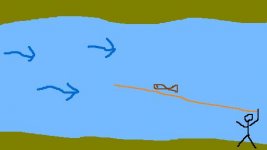I wish I was as good of an artist as many of you, but unfortunately I can't put a visual to my explanation. In those circumstances if there was no other possible way to present to this fish, I would make a wiggle cast upstream on the near bank possibly 20/30 feet ahead of this fish. While the wiggle is working itself out in the current, I would get out as much line as I could on the water and make a very large downstream mend behind the fish hopefully getting enough line that the mend extends past the fish towards the opposite bank. As the current begins to work out my mend, it should drag the bugger on an angle towards the far bank and hopefully somewhat near that fishes mouth. That being said, it all depends on how wide the stream to be able to make that downstream mend past the fish. Also, I would suspect the water conditions are a little tricky, so you have to be careful not to slap your mends on the water as well. Just my suggestion, but as suggested from the different responses, there is more than one way to skin a cat...or if you are creative as some on here there is more than one way to use your cat's fur for dubbing.




